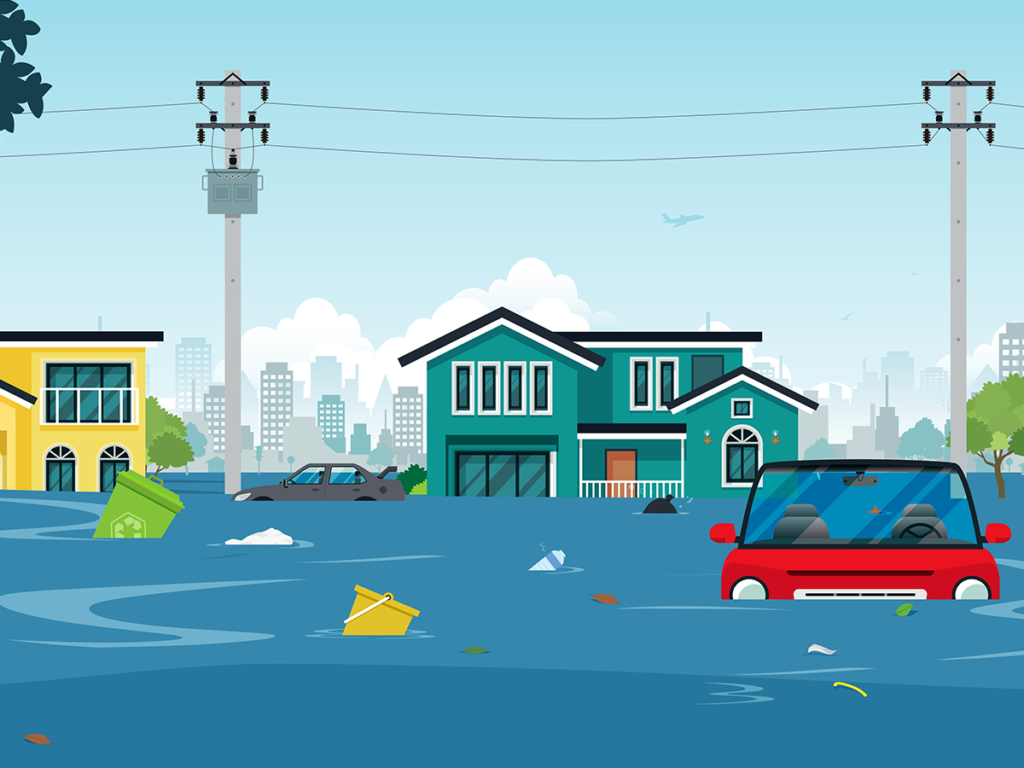What is flood insurance and what does it cover?

Did you know that flooding is the most common type of natural disaster in the United States? Furthermore, flooding occurs in 90% of all U.S. natural disasters, leading to billions of dollars in damages every year.1 You might be surprised to learn that flooding – although extremely common – is not typically covered by a standard home insurance policy. But don’t worry, there are options available to cover your property from flooding, which typically requires you to purchase a separate flood insurance policy.
What exactly is flood insurance?
Flood insurance is usually purchased in addition to home insurance and can protect your property and its contents up to a certain amount, dependent upon the coverage limits of your policy. In many areas, you can purchase flood insurance through the National Flood Insurance Program (NFIP). Recently, some private insurers have begun offering this type of protection as well. Your insurance experts at Answer Financial always recommend comparing quotes and coverages to make sure you’re getting the right protection for your situation and needs.
What is covered by flood insurance?
When comparison shopping for flood insurance, it’s smart to make sure you know what type of flooding is covered. Most flood insurance covers:
- direct physical losses
- damages resulting from a flood or flood-related erosion
- damages from heavy or prolonged rain, snow melt, coastal storm surge, blocked storm drainage systems or levee dam failure, among others.1
Your insurer may also have some criteria about what is considered a “flood.” For example, if the flooded area was on less than two acres or didn’t affect multiple properties, your insurer may not consider it to be a claim-worthy event.
Do I need flood insurance if I don’t live in a flood zone?
Some people assume they don’t have a need for flood insurance if they don’t reside in a flood zone or near a river, but that may not always be the wisest decision. Flood awareness is important, especially if you live near:
- creeks or ponds
- an area that gets heavy snow
- near a steep hill with water runoff
- an urban or suburban neighborhood
If you’re in a geographic region like one of these, it’s smart to consider purchasing an affordable flood insurance policy. For people living in developed areas packed with impervious surfaces like parking lots, roads and sidewalk, urban flooding (sometimes referred to as urban runoff) can be a risk. If an event like a hurricane were to happen, heavy rains could cause flooding from excessive runoff.2
There may not always be a flood warning before one comes your way, so we recommend preparing for the worst, so your property is covered and protected.
Are there differences between NFIP and private flood insurance?
One benefit of choosing a private insurer instead of the NFIP is the option to buy higher coverage levels, if needed or desired. If you’re concerned the value of your home or its contents may exceed what a standard policy usually covers, private flood insurance could be a worthwhile option.3
Most – if not all – NFIP policies do not take effect for the first 30 days after purchase. Private flood insurers may offer shorter waiting periods. If you have concerns about getting a policy in place quickly, private flood insurance might be your best bet. You don’t want to wait for a disaster to strike before getting your flood insurance in place.
What should I do before a storm to protect my property?
If you live in a region that’s prone to flooding, being a homeowner could be a bit daunting. Although a natural disaster like a flood is often unavoidable, there are some actions you can take to protect some of your more valuable property. If you live in a two-story home and know a flood is on the way, move your most expensive furniture and items to the second story to avoid any water damage.
You can also purchase sandbags to try and blockade water from entering your home. Stack them like bricks along the exterior perimeter to create a flood water barrier. Lastly, don’t forget to create a flood safety kit so you have first-aid materials and other emergency items within arm’s reach if disaster strikes.
Photographing your property and belongings can also be important if you ever need to file a flood insurance claim. The more documentation you can provide to your insurer, the better. As your insurance experts, we recommend taking photos of your home’s foundation, the interior and exterior walls and the contents of your home. It’s important to prove the condition of your property before a flood occurs so your insurer is able to quickly and accurately assess any damages.
Who is Answer Financial?
Answer Financial is one of the largest personal lines insurance agencies in the U.S. and works with dozens of top-rated carriers to bring consumers like you the right fit for your auto, home, renters, flood, motorcycle and other insurance needs. We understand no two situations are alike, which is why customers consider us to be a smart choice when looking to compare, buy and save on insurance.
On our mobile-friendly website, insurance shoppers can quickly compare rates and customize coverages from multiple companies. If you have any questions along the way, our insurance experts are standing by to provide over-the-phone guidance. Over the years, we’ve helped more than 5 million people like you review their current policy and find affordable home insurance for their needs. You can speak with us at 1-800-258-5101 to buy or change your coverage from top-rated insurance companies.
December 19, 2023
Sources:
- Insurance Information Institute, “Spotlight on: Flood Insurance,” https://www.iii.org/article/spotlight-on-flood-insurance
- Risk Factor "What is Urban Flooding?” https://help.riskfactor.com/hc/en-us/articles/360048726353-What-is-urban-flooding-Visit-Risk-Factor-to-check-your-risk
- Insurance Information Institute, “Do I need flood insurance for my home?” https://www.iii.org/article/do-i-need-flood-insurance-for-my-home
